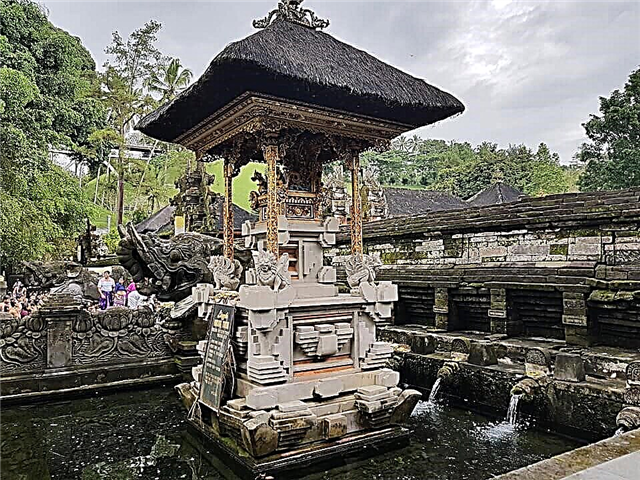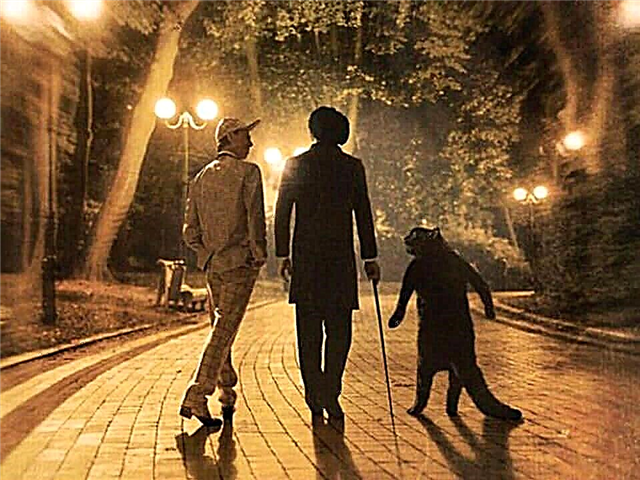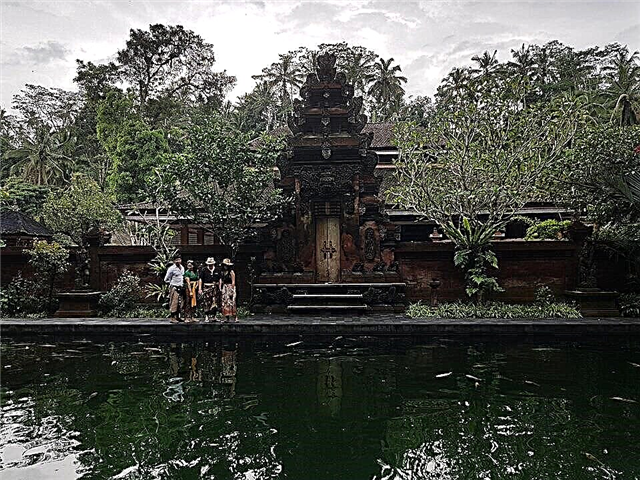The Tirta Empul Temple in Bali is an unusual place loved by tourists from other countries. Actually, this is a whole complex where you can spend the whole day, study the customs of the Hindus, have a great rest, and not get bored. Hinduism pays great attention to water. For believers, an ocean, lake or river is a source of life and prosperity. All temples are located near water surfaces. It is here that visitors get healthier, calm down and tune in to prayer. This place is steeped in legend. In ancient times, a king lived on earth, who was so confident in his own power that he began to defy the gods. He stated that the inhabitants of heaven are worthless creatures, and he, Maya Dinava, independently protects his subjects, gives them food and protects them from harm. And the honor should be offered to him, not to the gods.
In the end, his taunts insulted the god Indra. He sent a heavenly army to pacify May Dinava. But it so happened that the earthly army defeated the heavenly one. After such a success, Maya Dinava finally became proud: he poisoned all the sources in his domain. The surviving angels drank the poisoned water and died in terrible agony. Then God sent a fiery snake (lightning) to the earth, and where it struck, springs of healing water broke out of the earth, which still exude water. Indra sprinkled his soldiers and resurrected them. People saw the power of the gods and executed May Dinava. And in the place where the lightning struck, grateful believers built a temple in 926. Next to the complex there is a villa for high-ranking guests who wish to relax in peace and privacy in this wonderful place.
Construction history

Tirta Empul is one of the most famous temples in Bali. The structure was built in 962 AD on the site of a spring. The first historical information about the emergence of the cult of holy water in these places is mentioned in ancient mythological legends. At one time, the ruler of the island of Bali was Maya Danava. The king forbade his subjects to worship deities and believe in higher powerful forces. The dictator and heretic felt unpunished, mocked and showed disrespect for the gods. According to legend, the warrior God Indra could not accept this. He sent his divine warriors to overthrow the tyrant from the throne. In spite of everything, the king destroyed all the soldiers who descended from heaven.
Indra was very angry - it is useless for a person to interfere with divine plans. God hit the ground with his staff. Water gushed from the formed well. Indra sprinkled this water on the fallen soldiers, and they came to life. After drinking the water from the holy spring, the Warrior God felt a spiritual relief. The belligerent desire to destroy the king has passed. Indra chose the path of reconciliation. Thus, the temple of Tirta Empul was erected on the site of the source. The further fate of King May Danava is unknown. Perhaps he was banished or the healing water changed his essence as well.

The temple is surrounded by picturesque nature, where dense evergreen trees and shrubs grow. The architecture of the main building of the temple impresses with its sophistication and grace. The sanctuary is made of wood and stone elements, decorated with gilding and covered with fine carvings. Near the temple of Tirta Empul there is a wooded hill, from where the interior of the sanctuaries is perfectly visible. During the European colonization of the island of Bali, the Dutch built a beautiful manor for officials here. It later became the seat of the first president of independent Indonesia.
Architecture

This wonderful complex consists of 3 parts communicating with each other. Each part has a special purpose and is separated from the neighboring ones by a gate:
- All tourists start their sightseeing from Jaba Pura, or the central courtyard. There are shops with souvenirs and food on the territory. Here you can have an inexpensive snack and buy sarongs, as well as baskets with sacrificial fruits and sweets, which you will need to visit the temple and healing springs.
- After walking through the impromptu bazaar, tourists go through the gates to Jaba Tengu, or the central courtyard. Here is the Tirta Empul Temple. The abundance of gilding, carved details from stone and minerals is impressive. Everywhere there are statues of gods (Hinduism professes polytheism), terrible demons who are defeated by the gods. Many images of animals. Separate pavilions have been erected in honor of the 20 main gods. If you wish, you can pray or make a wish in the temple by bringing a basket, bought in advance, as a gift to the gods. The area is planted with trees, it is always cool here.
- And finally, the part where the healing springs are located is Jeroan, or the backyard. Only two pools are available for the daily bathing of tourists. And the third one is used by believers for rituals on holidays: it is closed for ordinary visitors. The first reservoir from the entrance provides ideally clean drinking water - amrita. It has a sandy bottom, spouting springs raise grains of sand, and it seems that a human heart is beating below. The second is carved into stone, and water enters it through 12 fountains. 10 cleanses the body and soothes the soul of the living, the last 2 are used to wash the dead before cremation. They are painted in a special color; no one from the locals approaches them. The last basin is inhabited by koe carps and aquatic plants. Fish can be fed and photographed.

On the territory of the temple complex, you can spend the whole day, moving from one courtyard to another, studying the traditions of Hinduism.
What to see

The main attraction of Tirta Empul is the font located in the courtyard of the temple. These are three stone pools filled with spring water. One pool with taps is filled with a continuous flow of water from the holy spring. Thousands of Balinese come here for rituals, prayers and bathing. There are 13 cranes in total, which have their own names.
There is a belief that each fountain has its own separate healing property. These are jets of water from various diseases, the evil eye, getting rid of demons, for improving health, having children, increasing well-being, acquiring an antidote, and so on. There are large statues of the Garuda Demon around the font. These are winged mythological creatures with a human body and a bird's head. They seem to be watching the bathing and prayers of believers.

The second font is considered to be the spring itself. The surface of the spring water is covered with multi-colored lotus leaves and water lilies. Pure and transparent water gushes out of the ground. This extraordinary sight has been compared to a throbbing heart. The third pool is a large pond. Huge multi-colored carps swim in it. Swimming in the pond is prohibited, but you can feed the fish.
In addition to the main building of the temple, small stone pavilions are installed throughout the area, intended for worship and prayers to various deities. The structures are decorated with exotic mythological sculptures. In total, there are about 20 sanctuaries. Unique sculptures of animals, birds and people are everywhere. Beautiful tropical flowers are planted along the paths leading to the pavilions.
The legend of the temple and the source

For many centuries on the island of Bali, sacred traditions and rituals of worship of divine powers were passed from generation to generation. All this is for the sake of achieving harmony of soul, body and spirit. For the people of Bali, this is more than legends, traditions and religious practices, they are considered the meaning of life. Only people dressed in a sarong can enter the territory of the Tirta Empul temple. Sarong is the clothing of local residents in the form of a fabric that completely covers the lower part of the body. According to tradition, each parishioner should have two robes: one for swimming in the pool, the other for prayer.
Before taking a bath in the holy spring, it is necessary to bring baskets with gifts to the gods and to each fountain. These can be rice, sweets and fruits. Believers light incense sticks, close their eyes, and take three deep breaths. At this time, they set themselves up for the ceremony, forgetting about their problems. And only then they enter the water. Men are allowed to go naked into the baptismal font. A woman must wear clothes that cover her shoulders, and must also tie her long hair with an elastic band.
While in the pool, next to the faucet of the holy spring, the believers must wash their faces three times and fill their mouths with water three times. Then you need to put the basket with gifts on the tap and pray. Only after this is it allowed to put the head under the stream of water three times. This is how the ritual of purification is performed in front of each fountain. This does not apply to just one tap, from which water flows out for ablution of dead people.
It should be noted that such a strict code of conduct applies only to pilgrims. In the bulk, the Balinese perform the purification ritual in an arbitrary order, but in compliance with the basic canons. Tourists are allowed to undergo this ceremony, according to their beliefs and understandings. The main thing is not to offend the feelings of local believers with your actions.
The most basic rule for travelers is not to walk around the temple in wet clothes. Diving into the pool is possible only after visiting all the sanctuaries. It is quite crowded here on Saturdays and Sundays. You can stand in line for a long time to bathe in the spring. For true believers, waiting in the font is not painful.
INAYA Putri Bali
Bali
Located along the beach in the tourist area of Nusa Dua

Hard Rock Hotel Bali
Bali
Rock 'n' roll styled next to Kuta Beach

Munduk Moding Plantation Nature Resort & Spa
Bali
Luxury suites and villas

Udara Bali Yoga Detox & Spa
Bali
It offers an outdoor pool and other amenities

Amnaya Resort Kuta
Bali
It offers an outdoor pool and other amenities

Travel tips before visiting

The temple is functioning, so services are held there, and local residents come here to pray on their own and bring gifts to the gods. Tourists should follow simple rules so as not to offend the feelings of believers:
- Moving around the complex is allowed only in the sarong.
- Bathing in the pool should be done as a last resort: it is prohibited to enter the temple in wet clothes. But if you have a spare one, you can go into the booth next to the fountain and change into dry clothes.
- Men are allowed to enter the water with a naked torso, and women, in addition to the sarong, are required to wear a T-shirt to cover their shoulders.
- Ladies should tie their hair with an elastic band, loose hair is not allowed. An elastic band, like a sarong, can be purchased at Jaba Pur, that is, the central courtyard.
- It is recommended to leave unnecessary things in the luggage room in Jaba Pur.
- The ablutions should be performed only after the offering of sacrificial offerings, which can be purchased in Jaba Pur.
- You should refrain from visiting the fountains, which are used to wash the departed before cremation.
- It is forbidden to swim in the pool: it is used only for ritual activities.
- Ladies are not allowed to enter the territory on critical days.
- Believers who pray should be treated with respect: it is forbidden to disturb them during rituals.

Opening hours and prices
On ordinary days, tourists can visit the temple complex for free. You won't have to pay for moving from one yard to another either. But on weekends and holidays, an entrance ticket is required for $ 1.25, half for the child. For this amount, you can walk from 7 am to 6 pm.
Where is it located and how to get there

The Tirta Empul Temple is located in the central part of Bali, 15 km from the city of Ubud. The travel time from the airport to the temple is two hours. This is one of the most popular places visited by tourists from different countries. From the village of Tampaxiring, the holy spring can be reached on foot along the winding paths, having previously studied the map of the area. It is advisable to take a tourist tour, where the guide will be able to accurately explain the rules for carrying out the rituals of ablution and purification in holy water.
There is a great opportunity for travelers to explore the ancient culture of the Balinese. To pacify the soul and body, this trip will be very useful for people who permanently live in megacities.











